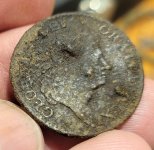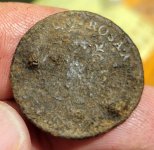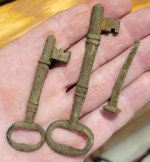- Mar 30, 2020
- 445
- 3,166
- Primary Interest:
- All Treasure Hunting
Today I found my second Rosa Americana token, and like my first one she is rough. Has the Tudor rose on reverse. Their funky metal composition made these coins rough from the mint and they do not hold up as well as British and early American coppers buried in the ground. But a great piece of early colonial history nonetheless and I'm happy to own another. It's only my third King George I coin I've found detecting to date. I've made no attempt to clean it but it does have detail. What looks like warts seems like punch hits as opposed to good old corrosion but they could have been caused during the minting process. My Nox 800 picked it up at 4" depth isolated in the forest floor, pegged 18 in Field One with sensitivity maxed at 25.
For those of you unfamiliar with these William Wood token series, here is a description posted on the coins.nd.edu website:
"The coins were made of an alloy called Bath metal composed of 75% brass, 20% zinc (mixed with tin and bismuth) and 5% silver and were to weigh slightly less than half the weight of English coins. The Bath metal planchets had to be hot when they were impressed between the dies to keep the dies from cracking. The heating of the planchets caused gas bubbles to form in the metal, as the planchets were struck while they were hot, these small bubbles did not have a chance to escape and therefore they produced a porous surface on the coins, often with some discoloration."
And it's my second time to find two skeleton keys in one day. I found them hours and hills apart.
We will see what tomorrow brings as I will be back at it.
For those of you unfamiliar with these William Wood token series, here is a description posted on the coins.nd.edu website:
"The coins were made of an alloy called Bath metal composed of 75% brass, 20% zinc (mixed with tin and bismuth) and 5% silver and were to weigh slightly less than half the weight of English coins. The Bath metal planchets had to be hot when they were impressed between the dies to keep the dies from cracking. The heating of the planchets caused gas bubbles to form in the metal, as the planchets were struck while they were hot, these small bubbles did not have a chance to escape and therefore they produced a porous surface on the coins, often with some discoloration."
And it's my second time to find two skeleton keys in one day. I found them hours and hills apart.
We will see what tomorrow brings as I will be back at it.
Attachments
Upvote
31









